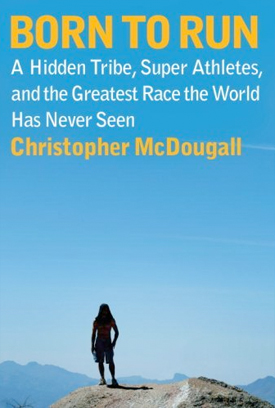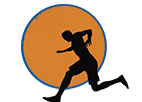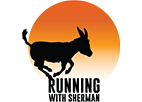“Who was the mysterious White Horse?”
Thanks to the BBC magazine, I had a chance to memorialize Caballo right after I got home from the search:
4 April 2012
Ultra-running: Who was the mysterious White Horse?
The long-distance runner Michael Randall Hickman, also known as Micah True, White Horse or Caballo Blanco, was a talismanic figure for ultra-runners until his recent death. He befriended an enigmatic tribe of super-athletes and inspired many to take up ultramarathons, writes friend and Born to Run author Christopher McDougall.
The mysterious thing about the disappearance last week of Micah True – better known as Caballo Blanco, the White Horse of the Sierra Madre mountains – was that for once, we knew where he was.
He wasn’t bushwhacking a secret new route through the Mexican outback because he heard a bandit was laying in wait for him on the old one.
He hadn’t set off at sunrise to run all day through Mexico’s Copper Canyons to visit the hidden homes of his friends, the reclusive Tarahumara Indians. He wasn’t clattering across the Mojave in an ancient pickup truck, hoping to earn a few more months of food as a vagabond furniture mover.
Instead, he filled a water bowl for his pup, told a friend he’d be back before lunch, jogged three miles down the road toward a nice, safe, American wilderness park in Gila, New Mexico – and vanished.
The news got out last Thursday. By first light on Friday, friends and fans of the Horse who’d driven all night to get there were lining up to join search and rescue teams. Among them were champion ultra-distance runners like Kyle Skaggs and Scott Jurek, the US 24-hour record holder. The actor Peter Sarsgaard would soon arrive.
I was 750 miles away when I found out, but so many people were speeding down from so many directions, it took only two calls and ten minutes to find a ride. I climbed in next to Luis Escobar, a photographer and race director I’d met when we’d last gone in search of the Horse six years ago.
I first heard about Caballo Blanco in 2005, when I was trying to learn the secrets of the Tarahumara, who call themselves the “Running People”. For centuries, fantastic tales of Tarahumara speed and endurance have drifted out of the Copper Canyons in northwestern Mexico, and on rare occasions, so have the Tarahumara.
In 1993, a 55-year-old Tarahumara runner in homemade sandals and his native toga appeared at the starting line of the Leadville Trail 100 – a gruelling race through the Rocky Mountains equivalent to nearly four full marathons – and defeated a field of elite international athletes. The following year, another Tarahumara runner shattered the course record. Then they retreated to the canyons, never to return.
If you study video of that 1994 race, you’ll see a tall, lanky figure running step-for-step with a Tarahumara runner. He’s there for an instant, then slips off to the side just before the finish line and disappears into the crowd.
He was an ex-professional boxer, I discovered, who was recovering from a broken heart with long, rambling runs across the Colorado trails. When the Tarahumara needed someone to guide them for the last 50 miles of the race, he volunteered.
Something about that night – about the experience of whisking silently through the dark by the side of a stranger from another century – must have affected him deeply, because soon after the Tarahumara left, Michael Randall Hickman went after them.
He’d be reborn – first as Micah True, self-named seeker of ancient wisdom, and then, to the Tarahumara children he entertained by snorting and stomping, as Caballo Blanco.
By the time I tracked him down, he’d spent nearly 15 years living among the Tarahumara. Their secret, Caballo told me, was simple – the Tarahumara remember that humans are creatures of constant motion, and if we forget that we survived and thrived for most of our existence as long-distance runners, we’ll suffer the same consequences as any other caged animal – disease, mood swings, eating disorders, all-around misery.
“The Tarahumara aren’t smarter than us. They’ve just got better memories.”
Learn the fine art of running, Caballo told me, and you can change your life.
“Don’t fight the trail. Take what it gives you,” he began. “Lesson two – think easy, light, smooth and fast. You start with easy, because if that’s all you get, that’s not so bad. Then work on light. Make it effortless, like you don’t [care] how high the hill is or how far you’ve got to go.
“When you’ve practiced that so long that you forget you’re practising, you work on making it smooooooth. You won’t have to worry about the last one – you get those three, and you’ll be fast.”
Caballo’s dream was to let the rest of the world know there was ancient wisdom worth protecting down there in the canyons, and his method was to create a wild, multi-day running festival in the heart of Tarahumara territory.
Nine months after he’d shown me how to transform my technique, I was able to return to the Copper Canyons in 2006 with ace runners like Scott Jurek and Luis Escobar for the 50-mile Ultramaraton de Caballo Blanco. Since then, the race has grown beyond even Caballo’s wildest expectations – this year on 4 March, more than 400 Tarahumara and nearly 100 outside runners participated, including past New York City marathon champion German Silva.
“He was the happiest I’d ever seen him,” Will Harlan, one of Caballo’s friends, told me. “He seemed to have a tranquillity and centeredness, even as record numbers of Tarahumara descended on Urique to run the race.”
Barely three weeks later, Caballo began driving from Mexico to Arizona to visit his girlfriend, another runner who, like me and Sarsgaard and thousands of others, have been transformed by Caballo’s message. Along the way, he stopped off at the Gila Wilderness Lodge in New Mexico, a place he’d visited many times.
On Monday, he went for a six-hour run with Guadajuko, a Mexican mongrel he’d adopted and called “the ghost dog”. On Tuesday, he decided to do a quick 12-miler before hitting the road. Guadajuko’s paws were sore, so Caballo left him on the porch and told the innkeeper he’d be back in two hours.
Five days later, he was finally discovered by the side of a cool mountain stream not far from the lodge. His death is still a mystery. But one of the running buddies who found him said Caballo looked peaceful – as if he’d stopped for a nap at the end of a long, glorious ramble through the woods, and never woken up.



